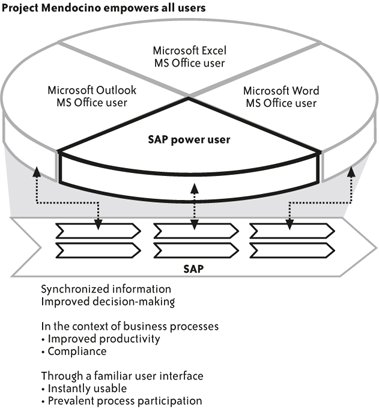Section 9.3. Project Mendocino applications
9.3. Project Mendocino applicationsProject Mendocino provides applications that support four primary business processes (see Figure 9-3) through data accessible on the desktop. They include:
Project Mendocino and its associated applications do not replace other UI strategies or solutions that SAP has in place already. Rather, access to these other UIs, most dominantly Figure 9-3. Project Mendocino version 1.0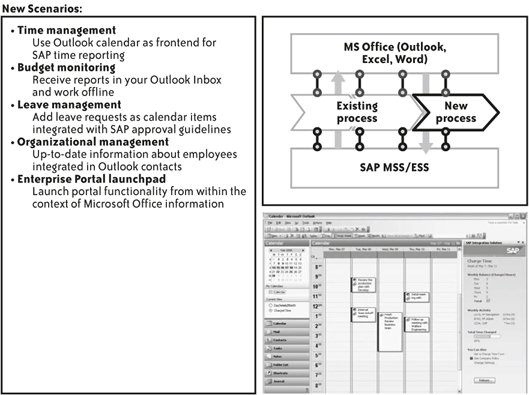 the SAP Enterprise Portal, is made easier for the user, and certain processes are frontended within Microsoft Office. A financial controller, for instance, has a full-featured and flexible solution within existing SAP applications and for the purpose of his tasks, a financial controller will not see a lot of benefit from working inside of Microsoft Office or Outlook other than having access to reports, approval processes, and self-service scenarios. As with any other technology, organizations must determine which business scenarios deliver the most value from within Project Mendocino. The unique advantages of this technology cannot be applied in every use case. Managers and cost center owners, for example, will benefit greatly by having access to information, alerts, notifications, and reports in a simple environment that is already used on a regular basis. Project Mendocino also alleviates the need for expert users who are in charge of providing a whole group with information in the system on an as-needed basis, thus creating bottlenecks in productivity (see Figure 9-4). Project Mendocino makes it easier for information workers to perform corporate-driven tasks through the following features:
SAP chose to include the aforementioned applications in Project Mendocino because they provide several organizational benefits, including:
9.3.1. What is the goal of the Time Management application?An ideal time management solution enables a knowledge worker to record the time spent working throughout a week or month without the need for timesheets, memorization of billing codes, manual data collection from multiple business systems, and questions about cost centers. Information workers could arrange a meeting online or offline using a familiar desktop application, such as Microsoft Outlook, and be automatically prompted with questions that facilitate account charges. Outlook would prompt the worker with the most recently charged account selected as the default, and a list of other relevant accounts. If the meeting was extended within the calendar application, the billing updates would be performed automatically. Pertinent information such as the total number of hours billed to each account, and unaccounted hours, would be accessible as well. Managers would be alerted to approve a charge and ensure budget compliance. Quick reference links would let employees view detailed statistics and company policies. Essentially, the solution would provide easy access to the task's relevant information, eliminate time spent searching for information, and enhance the decision-making process. Project Mendocino's Time Management application, shown in Figure 9-5, is capable of performing every one of those tasks. One of the biggest benefits of the Time Management application is that it allows information workers to keep track of project time without the overhead of filling out a timesheet. Time recording activities can be initiated directly from an Outlook calendar appointment. Information workers can review and edit data if necessary and preset time recording defaults in their Outlook preferences for frequent activities. The information worker also has access to the Time Management application when offline. When her system goes back online, the data will be automatically submitted into the system of record. Figure 9-5. The Time Management application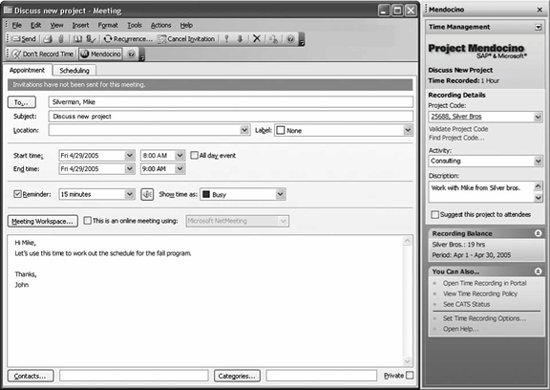 The Time Management application extends the standard Outlook appointment object to include a means of logging time and selecting a charge code to go with it (see Figure 9-6). This is known as an appointment object with time logging entry. Information workers can log whole days to a charge code or assign multiple appointments in a single day to different charge codes. The information worker can also select a view in Outlook that displays only appointments that are associated with a particular project code. Likewise, all meetings that are not yet associated with a charge code can also be viewed and managed. And the information worker can define a default project code that will be assigned to times with no meetings or unassigned meetings in the calendar. The SAP action pane also carries time-logging contextual information, such as an overview of the available charge codes. This also gives each user a way to view data related to his timesheet, such as total percentage of time logged to a particular project. So what happens when an employee goes into the calendar and begins deleting or archiving a meeting from two months ago? The SAP system controls the data, so even though the appointment might be erased from the individual user's calendar, it does not disappear from the database if it has been approved, unless the user explicitly asks for this. This ensures that the correct business functionality is accomplished while also giving the user the ability to use her calendar program in a personalized manner. Figure 9-6. Charging time in the Time Management application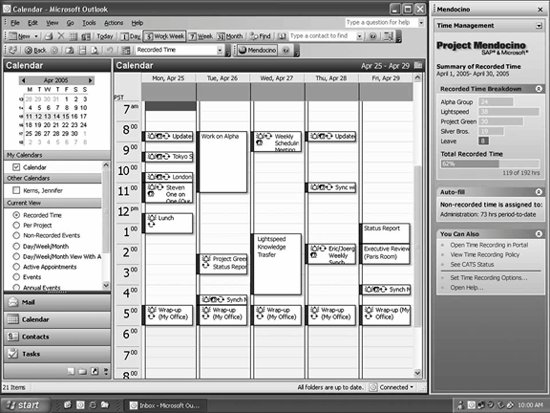 9.3.2. What is the goal of the Leave Management application?Every time an information worker requests leave using Microsoft Outlook, it triggers a workflow that is fully incorporated with backend services through ESA. The employee puts in a leave request, and the manager will approve or deny it. To these two information workers, the process appears as nothing more than entering information in the familiar Microsoft Outlook interface, but the emails are actually controlled through workflows that are accessible through ESA. But that is only the simplest form of leave management. What use is a leave time request and approval without the relevant contextual information to go with it? How much leave has been accrued, for instance? Until the day an information worker decides to request leave, the amount of vacation time he has accumulated is immaterial. So, for instance, if an information worker is getting married, he knows that a particular number of days are allotted but has no clue how manyor, for that matter, where to find the information inside the system. With Project Mendocino, the contextual information regarding leave days is delivered within the Outlook calendar appointment. An information worker can click on the appropriate link in the Mendocino action pane and find out that marital leave is five days. Microsoft Office supplies the environment and Project Mendocino provides the functionality to enable this transaction. Within the Outlook calendar, information workers can create, monitor, and view all calendar-specific activities. The leave request object looks similar to the appointment/meeting object in the Outlook calendar. This object is the primary way that information workers will enter leave requests through the Outlook calendar. Information workers can request whole days, as well as fractions of a day, depending on the leave types configured by the customer (a half-day vacation, for example). The Leave Management system allows information workers to create leave requests from several different places within Outlookby selecting the range in the Outlook calendar, for instance, or by choosing it from a menu. Contextual information related to leave request types as they are configured on the employee self-service (ESS) system (vacation, maternity leave, jury duty, etc.) will be available in the action pane. This will also include such information as leave entitlement, leave availability, and leave taken. The Leave Management system fills in predictive data such as the approving manager's name. But the information worker will be able to change that data if necessary as well. And the Leave Management application capabilities will be available offline. When back online, the system executes the action by submitting the leave request to the backend server. Leave request information originating in Outlook is synchronized to ensure that the data is updated when changed through other means, such as ESS. Managers use the Leave Management application in a different way than employees do, and Project Mendocino can be personalized for their needs, too. The approving manager has the ability to approve or reject a leave request from within Outlook, for example. This is achieved by presenting the manager with an intuitive interface that is similar to a meeting request approval. Employees are then notified within Outlook that the leave request has been approved or rejected. Approving managers can also view leave status for entire teams through the team calendar. A manager can create reports through her access to the team's leave status. 9.3.3. What is the goal of the Budget Monitoring application?When a manager wants to be notified about emerging budget issues, she can easily set an alert: "Please notify when term costs are exceeding 50 percent or if I have a single posting to the account exceeding $10,000." That is the most basic level of control required on any budget management tool. But the Budget Monitoring application in Project Mendocino, shown in Figure 9-7, incorporates a much deeper level of reporting. It includes the ability to be notified by the system about the current status of a team's budget use, its cost center, and the cost-specific projects. These reports can be customized and triggered for regularly scheduled delivery to an Outlook inbox. When a manager selects a report template, or is in the viewing mode of a report, she can define the delivery schedule and frequency of delivery through the action pane. These settings are stored for each user and are reported in the Mendocino Server as personalization values. The reports are then distributed to Outlook. A manager will even be able to initiate a budget transfer (as shown in Figure 9-8), posting an adjustment directly from a received alert through integration with forms or by drilling down into the SAP Enterprise Portal. When authorized, an information worker could then have the ability to make a budget transfer or trigger a workflow to the area controller from there. Figure 9-7. The Budget Monitoring application There are several ways to view reports in the Outlook folder, including through a role-based list. Within the report view, the user will be able to:
Project Mendocino delivers reports in multiple formats: text only, data only (XML), formatted (MHTML, native .xls files), or any mixture thereof based on user preferences. Project Mendocino can even map the incoming data to a user's local XML template, which is based on Excel templates, allowing for formatting according to the individual user's needs. The Budget Monitoring application provides managers with all the time-critical information required to effectively monitor their budgets. This happens via alerts and notifications in the Office environment, as well as with ongoing financial reports, allowing managers to recognize critical postings and variances, and to take immediate action on them. Managers have access to information such as the company's budgeting and budget handling policy as well as extensive analytics. Access to some of this data may require drill-down functionality to the SAP NetWeaver Portal, which is seamlessly integrated. Figure 9-8. Budget transfers in the Budget Monitoring application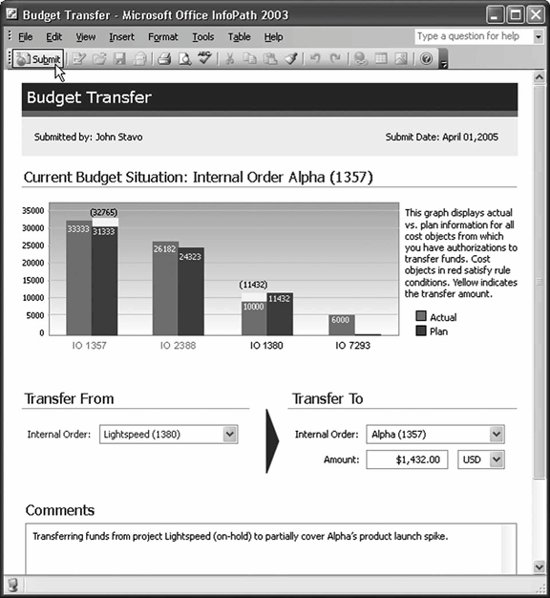 The administrative user also has specific abilities that are enabled by the Budget Monitoring application. An admin can define existing reports in the underlying system and make them available for distribution to end users based on roles (this is known as a reporting catalog). When defining the reporting catalog, the admin user first defines which report to make available. Then he defines the selection parameters, delivery mechanism (HTML, Excel, etc.), and frequency for it to be made available to the end user. A list of basic Budget Monitoring report templates will be included in the standard delivery of Project Mendocino. Reports that are defined by the admin user for distribution are executed by the backend server. Upon creation of the report, the report will be converted to an Outlook item and enriched with metadata. 9.3.4. What is the goal of the Team Management application?The Team Management application provides contextual personnel and organizational information to the Project Mendocino user through the Microsoft Office environment. It allows managers to use the Outlook Contacts view to browse and display contact details about team members and subordinates. For managers, Team Management also displays additional contact information supplemented by personnel data gathered from the Human Resources backend system. This includes compensation data (salary, compensation ratio, etc.) and related files (e.g., employee files). Adding an information worker's HR-related file from the Outlook client to a related component in the file management system is as simple as dropping an email or document into a corresponding folder with the team member's name. The information provided and activities enabled depends on SAP security and the user's structural relationship to the contact (My team, My data, Colleagues, etc.). Information workers can display organizational data, such as org charts, alongside contacts data and have it supplemented by related data from the Human Resources backend system. |
EAN: 2147483647
Pages: 265
